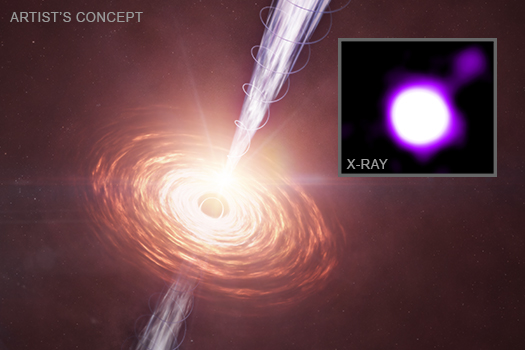For Release: June 9, 2025
NASA/CXC

Credit: X-ray: NASA/CXC/CfA/J. Maithil et al.; Illustration: NASA/CXC/SAO/M. Weiss; Image Processing: NASA/CXC/SAO/N. Wolk
Press Image, Caption, and Videos
A black hole has blasted out a surprisingly powerful jet in the distant universe, according to a new study from NASA’s Chandra X-ray Observatory. This jet exists early enough in the cosmos that it is being illuminated by the leftover glow from the big bang itself.
Astronomers used Chandra and the Karl G. Jansky Very Large Array (VLA) to study this black hole and its jet at a period they call “cosmic noon,” which occurred about three billion years after the universe began. During this time most galaxies and supermassive black holes were growing faster than at any other time during the history of the universe.
Scientists can use this jet to probe questions about how black holes helped shape their surroundings during this critical era in cosmic history.
“We’re finding that some black holes may carry a bigger punch at this stage in the universe than we thought,” said Jaya Maithil of the Center for Astrophysics | Harvard & Smithsonian (CfA) who led the study.
Maithil and her colleagues identified and then confirmed the existence of two different black holes with jets over 300,000 light-years long. The two black holes are 11.6 billion and 11.7 billion light-years away from Earth respectively.
“With its unmatched X-ray resolution, Chandra was able to detect these jets despite their immense distances and small separation from the bright quasars,” said co-author Dan Schwartz, also of CfA. “The X-rays are cosmic microwave photons amplified one million times by electrons accelerated by the supermassive black hole.”
As the electrons in the jets fly from the black holes, they move through the sea of cosmic microwave background (CMB) radiation and collide with photons producing the microwaves. The CMB was much denser then than it is now. These collisions boost the energy of the photons up into the X-ray band to be detected by Chandra.
The team also used the VLA to better understand the properties of the jets. They discovered that while the jets detected by Chandra align with the overall radio emission observed in the VLA data, a continuous radio jet matching the length of the X-ray jet is not seen. This difference makes sense because electrons that produce radio waves do not last as long as electrons that create X-rays through interactions with the CMB radiation, so enhanced X-ray emission is expected but not necessarily radio emission.
By combining the X-ray and radio data, the researchers calculated that the jets are moving at between 95% and 99% of the speed of light for one jet (called J1405+0415) and between 92% and 98% of the speed of light for the other (J1610+1811).
“These jets are going so fast that they are pushing up against the absolute speed limit of physics – the speed of light,” said co-author Aneta Siemiginowska, also of CfA.
In addition to the speeds of the two jets, Maithil and her team were also able to measure their magnetic fields and found they are typical for jets producing X-rays via an interaction with the CMB. They also calculated what direction the jets are pointing using the X-ray and radio data. They concluded that both are directed at angles of only about 10 degrees away from pointing straight to Earth.
These results were presented at the 246th meeting of the American Astronomical Society in Anchorage, AK, and are also being published in The Astrophysical Journal. A preprint is available here. NASA's Marshall Space Flight Center in Huntsville, Alabama, manages the Chandra program. The Smithsonian Astrophysical Observatory's Chandra X-ray Center controls science operations from Cambridge, Massachusetts, and flight operations from Burlington, Massachusetts.
Media Contacts:
Megan Watzke
Chandra X-ray Center, Cambridge, Massachusetts
617-496-7998
mwatzke@cfa.harvard.edu
Lane Figuerora
Marshall Space Flight Center, Huntsville, Alabama
256-544-0034
lane.e.figueroa@nasa.gov


